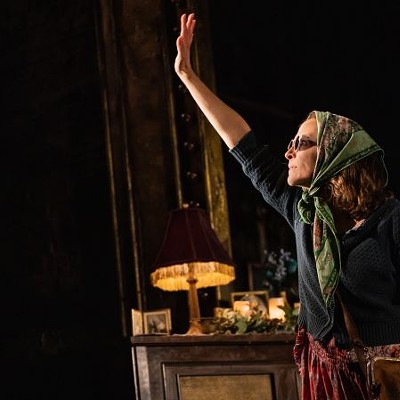To close out the current season, the University of Houston's Moores Opera Center presents a haunting fairytale opera in florid impressionist style by Mexican composer Daniel Catán. It is the composer's first opera, and it's sure to have viewers running home to prune back the springtime growth in their backyards.
La Hija de Rappaccini, or Rappaccini's Daughter, takes place on the streets of Padua, Italy and in Rappaccini's garden, where the centerpiece is a large mystical tree, an overt reference to the tree of the knowledge of good and evil in the Garden of Eden.
"This is probably the most musically complex of Catán's operas. His style got simpler as he went along. Yet, it's still really lush and beautiful.," said Buck Ross, director and founder of the Moores Opera Center.
"Catán was very conscious of the fact that the way that he was writing was going against what was the prevailing atonal style. Ironically, the world has kind of caught up with him now, because we're in an age of eclectic composing where people feel justified in using whatever style is appropriate in the situation that they're working with. For him, it was this really lush, incredibly beautiful and, in a way, traditional operatic sound."
Rappaccini is equal parts botanist and evil scientist; he uses knowledge and possibly a little sorcery to grow a poisonous garden. He harvests the plants' venom to grant his beautiful daughter Beatriz immortality. When Giovanni, a young medical student, falls in love with Beatriz and pursues her, he becomes grievously ill. His friend gives him an apothecary's cure to give to Beatriz, and, when she takes the herbs, she is destroyed.
Mark Thomas, a first-year master's student in vocal performance, plays the lead tenor role of Giovanni.
"The opera takes place in the late Renaissance to early Enlightenment period, when people were just beginning to really explore scientifically. It was a time when people were vivisecting things and pushing boundaries that were very firm up until that point," Thomas said.
"The experimentation makes me think of chemotherapy--you're injecting a poison into somebody to kill off cancer, and what is the real result of that? That makes the opera's interplay between science and how far we can take it very relatable."
La Hija de Rappaccini is a collaboration between Catán and librettist Juan Tovar, and it was premiered in 1994 at the San Diego Opera. It is based on a retelling by Mexican Nobel-Prize-winning author Octavio Paz of Nathaniel Hawthorne's story, "Rappaccini's Daughter".
Ross, who worked closely with Catán to coordinate the Moores's series of Catán operas, is not surprised that the composer chose to write an opera with so much literary history.
"Text was very important to him. He was a very well-read and educated man who was interested in opera in part because of its literary aspects," Ross said.
Second-year doctoral conducting student Arne Almroth will lead the music, while Ross directs the production. He designed the sets himself using computer-edited and generated images that will be projected onto the stage. In some scenes, a scrim is used--that's the screen curtain at the front of the stage that is often used to make scenes appear fuzzy or confused. Images will be projected onto the scrim that will make the characters seem to be in the ocean or on a balcony above a blooming garden.
This technique makes scene changes nearly seamless; instead of closing the curtain and moving bulky scenery, one scene merely melts into the next. Because of the ease of this technology, the 90-minute opera employs 50 projections.
"There's always something new to look at, and, for a modern audience that is used to things moving along more quickly, this will feel more like a film," Ross said.
This production was meant to be the last in a four-part series of Catán's operas produced by Moores. However, when Catán died unexpectedly in 2011, he had a final opera, "Meet John Doe," mostly completed. Another composer has completed the opera, and Ross believes that the Moores will produce it during the 2016- 2017 season to finish out the Catán series. It is Catán's only English-language opera.
"I think that new opera is something that audiences in Houston are kind of used to doing, because Houston Grand Opera has a long tradition of doing new pieces and so do we," Ross said.
"We're very conscious about making sure that the new pieces that we pick are things that are going to appeal to an audience that was raised on traditional opera and to somebody that has never walked into an opera before in their lives."
Kaylie Kahlich, a first-year master's student in vocal performance, sings the soprano role of Beatriz. She thinks that the opera might have another unique appeal to Houston audiences.
"It's not every day that you get to do an opera in Spanish. Typically, it's Italian, German, or French," Kahlich said.
"Spanish is an incredibly beautiful language, and we are in a place that has such a large population of Spanish-speaking people. It's been fun performing in a language that a lot of people know but not a lot of opera is done in."
The composer's widow will be presenting pre-concert talks 45 minutes before each performance. English surtitles will be projected above the stage. Rappaccini's Daughter runs April 10 to April 13. All performances take place at 7:30 p.m. except for Sunday, April 12 at 2 p.m. at the University of Houston's Moores Opera House, 4800 Calhoun. Call 713-743- 3313 or visit the Moores website for tickets. $12 students and seniors, $20 general admission.





